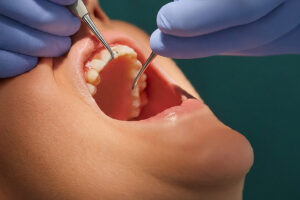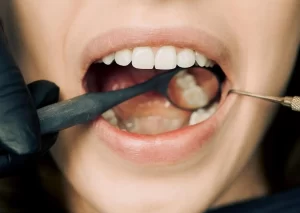Tartar Breaking off Teeth

Discover the truth behind tartar breaking off teeth in this comprehensive guide.
Tartar, also known as dental calculus, is a hard deposit that forms on teeth when plaque hardens. While it may seem like tartar breaking off could be a sign of self-cleaning teeth, it often indicates underlying oral health issues.
In this article, we delve into the causes of tartar detachment, explore effective prevention strategies, and highlight the best treatment options available.
Find out how to address tartar build-up and protect your teeth from potential damage.
Table of Contents
What is Tartar?
Tartar, also known as dental calculus, is a hard, calcified deposit that forms on teeth and below the gumline. It results from the mineralization of dental plaque, a sticky film of food debris, bacteria, and saliva.
Tartar can vary in color from yellow to brown and contributes to tooth decay and gum disease by providing a surface for plaque accumulation.
Its rough texture can also irritate gum tissues, leading to inflammation. Unlike plaque, tartar is too hard to remove with regular brushing and flossing and requires professional dental cleaning.
Tartar Breaking Off Teeth – What Happens When Tartar Breaks Off?
When tartar breaks off teeth, it might initially seem like a positive occurrence because tartar can be unsightly and contribute to oral health problems.
Still, tartar breaking off spontaneously is unusual and can indicate underlying issues:
- Damage to Tooth Enamel: Tartar adheres strongly to tooth enamel. If it breaks off, it might take some enamel with it, leading to increased sensitivity and risk for decay.
- Gum Damage and Infection: Tartar buildup occurs both above and below the gum line. If tartar breaks off below the gum line, it could leave behind rough surfaces that irritate the gums, potentially leading to gum infections or exacerbating conditions like periodontitis.
- Incomplete Removal: Tartar breaking off in chunks means that it’s unlikely all of it has been removed. Remaining tartar can continue to harbor bacteria, leading to further plaque accumulation and oral health issues.
- Underlying Oral Health Issues: Spontaneous breaking off of tartar might reflect advanced gum disease, where the gums recede significantly and no longer support the tartar, or it could indicate that the tartar is so thick that parts of it lose adhesion to the tooth surface.
In conclusion, while the removal of tartar is necessary for maintaining oral health, it should ideally be done professionally by a dentist or dental hygienist.
They can safely and thoroughly remove tartar without damaging the teeth or gums, and also address any underlying issues that its spontaneous removal may signify.
Is it Tartar Breaking off Teeth or a Chipped Tooth?
Differentiating between tartar breaking off and a chipped tooth is important for appropriate dental care.
Here are key distinctions:
Visual and Textural Differences:
- Tartar: It’s usually yellowish or brownish in color and forms along the gumline or between teeth. Tartar that breaks off might leave a rough or uneven surface on the tooth where it was attached.
- Chipped Tooth: A chip may reveal a lighter, possibly more sensitive layer of the tooth. The area of a chipped tooth might feel sharply uneven or jagged compared to tartar detachment.
Sensitivity and Pain:
- Tartar Removal: Might not cause pain unless the area becomes sensitive due to exposed enamel or root.
- Chipped Tooth: Can cause varying degrees of pain or sensitivity, especially when exposed to hot, cold, or sweet foods and drinks, due to the potential exposure of deeper tooth layers.
Location and Size:
- Tartar: Typically accumulates at the gumline or between teeth. If tartar breaks off, it might not result in a visibly missing part of the tooth structure.
- Chipped Tooth: The chip can occur anywhere on a tooth, often resulting in a visible defect in the tooth’s shape.
Response to Dental Hygiene:
- Tartar: Regular brushing and flossing cannot remove tartar once formed; it requires professional dental cleaning. If tartar does break off (which is rare without intervention), it might indicate excessive buildup.
- Chipped Tooth: Not influenced by dental hygiene practices. A chipped tooth is a structural damage that requires dental intervention to repair.
If you’re unsure whether you’re experiencing tartar breaking off or a chipped tooth, it’s best to consult a dental professional.
They can provide a definitive diagnosis and recommend appropriate treatment, whether it’s a professional cleaning to remove remaining tartar or a dental procedure to repair a chipped tooth.
Why Does Tartar Break Off and How Does it Happen?
Tartar breaking off teeth is relatively uncommon and usually indicates underlying oral health issues. It forms when plaque that is not removed by brushing and flossing hardens on the teeth.
This hardened plaque is strongly bonded to the tooth enamel and typically requires professional cleaning to be removed. If tartar does break off, it might be due to several reasons:
- Severe Dental Calculus: Over time, thick layers of tartar can develop, especially in areas that are difficult to clean. These thick layers might partially break off due to their own weight or during chewing, although this is not common.
- Gum Recession: Advanced gum disease (periodontitis) can lead to gum recession. As the gums pull away from the teeth, tartar that is below the gumline may become unstable and break off.
- Improper Cleaning Techniques: Using hard-bristled toothbrushes or applying excessive force while brushing can potentially chip off tartar, but this might also damage the enamel and gums.
Note that tartar breaking off on its own can leave rough surfaces that may irritate the gums and expose the teeth to further decay. Regular dental check-ups and cleanings are the best choices to safely remove tartar and prevent oral health problems.
What Should I Do If Tartar Breaks Off While Flossing?
If tartar breaks off while flossing, it’s an indication that you might have significant tartar buildup and potentially underlying gum disease.
Here’s what you should do:
- Continue Good Oral Hygiene: Keep brushing twice a day and flossing daily, but ensure you’re using gentle techniques to avoid damaging your gums or teeth.
- Rinse with Salt Water: Rinsing your mouth with a warm saltwater solution can help soothe irritated gums and reduce inflammation.
- Avoid Picking or Prodding: Do not attempt to remove more tartar yourself, as this can damage your enamel and gums.
- Schedule a Dental Appointment: See a dentist as soon as possible. A dental professional can assess your oral health, properly remove any remaining tartar, and treat any damage or disease that may have occurred.
- Discuss Preventative Measures: During your visit, discuss with your dentist or dental hygienist ways to improve your oral hygiene routine and prevent future tartar buildup.
Tartar removal is typically painless and is performed during a standard teeth cleaning.
What If There Is A Sharp Spot In My Mouth?
If you discover a sharp spot in your mouth, it could be due to a chipped tooth, broken dental work, or tartar buildup. Avoid touching or probing the area to prevent injury.
Rinse your mouth with warm salt water to soothe irritation. Schedule a dental appointment as soon as possible. Your dentist can identify the cause and provide appropriate treatment to prevent infection, relieve discomfort, and restore oral health.
Is it Possible to Prevent Tartar Build-up?
Yes, it’s possible to prevent tartar build-up with good oral hygiene practices. Brushing your teeth twice daily with fluoride toothpaste, flossing once a day, and using an antiseptic mouthwash can help remove plaque before it hardens into tartar.
Regular dental check-ups and professional cleanings every 6 months are the key, as dentists can remove any tartar that has formed and provide guidance on improving your oral hygiene routine.
Reducing the intake of sugary and starchy foods can help minimize plaque formation, further preventing tartar build-up.
How to Prevent Tartar Build-Up
Here are 8 effective strategies:
- Brush Regularly: Brush your teeth at least twice a day using fluoride toothpaste. Pay special attention to the gum line, the back teeth, and other hard-to-reach areas.
- Use the Right Tools: Consider using an electric toothbrush, which can be more effective at removing plaque than manual brushing.
- Floss Daily: Flossing removes food particles and plaque between teeth and under the gumline, areas your toothbrush can’t reach.
- Rinse with an Antiseptic Mouthwash: Using mouthwash can help kill bacteria that cause plaque.
- Eat a Balanced Diet: Limit sugary and starchy foods and drinks, as they contribute to plaque formation. Instead, eat plenty of fruits, vegetables, and foods high in fiber.
- Stay Hydrated: Drinking water helps wash away food particles and keeps your saliva levels high. Saliva is natural protection against plaque.
- Quit Smoking: Smoking is associated with an increased risk of tartar build-up, gum disease, and other oral health issues.
- Regular Dental Visits: Visit your dentist or dental hygienist for professional cleanings and check-ups at least twice a year. These visits can remove any tartar build-up and catch potential oral health issues early.
Top 3 Ways to Gradually Remove Tartar from the Back of Your Teeth
Removing tartar from the back of your teeth at home can be challenging, as tartar removal typically requires professional dental tools and expertise.
You can take steps to minimize tartar formation and maintain oral health.
Here are the top 3 ways to address tartar buildup, especially on the hard-to-reach back teeth:
- Improved Oral Hygiene Routine: Enhance your daily oral care by brushing your teeth thoroughly for two minutes, twice a day, using a fluoride toothpaste. Pay special attention to the back teeth. Flossing daily helps remove plaque between teeth and below the gumline, preventing it from hardening into tartar.
- Electric Toothbrush: Switch to an electric toothbrush with a rotating-oscillating or ultrasonic action. These toothbrushes have been shown to be more effective at removing plaque than manual toothbrushes, particularly in hard-to-reach areas like the back of your mouth.
- Professional Dental Cleaning: While home practices can prevent tartar buildup, existing tartar cannot be removed safely without professional help. Regular dental check-ups and cleanings (every 6 months) are essential. A dental hygienist can thoroughly clean all surfaces of your teeth, including the back, removing tartar and plaque that you might miss during your routine home care.
It’s important to note that while these methods can help manage and prevent further tartar buildup, professional dental care is the only effective way to remove existing tartar.
FAQ on Tartar Breaking Off Teeth
Is tartar chipping off good?
Tartar chipping off is not typically considered good. While it may seem beneficial to have tartar break away, its spontaneous detachment can indicate excessive buildup or underlying oral health issues, such as gum disease. Tartar removal at home can lead to enamel damage or infection if not done correctly. Professional dental cleaning is the safest and most effective way to remove tartar and prevent potential complications.
Can teeth fall out during tartar removal?
Teeth are unlikely to fall out during professional tartar removal if they are healthy and properly supported by the surrounding gums and bone. Dental professionals use special tools and techniques to safely remove tartar without damaging the teeth.
If a tooth is already severely loosened by gum disease or bone loss, the process might highlight the extent of the damage. In such cases, a dental professional will assess the situation carefully and may recommend further treatments to address the underlying issues.
Can you scrape tartar off your own teeth?
Fact Checked
Our dedicated team rigorously evaluates every article and guide to ensure the information is factual, up-to-date, and free of bias.
Updated Regularly
We update our articles and reviews regularly to ensure you have access to the latest data in the dental industry.
The content on Dental3DU’s blog is intended for educational purposes only. This information should not be relied upon as professional medical counsel. Be sure to always consult with your dentist about the dangers and benefits of any medication, treatment or procedure.







